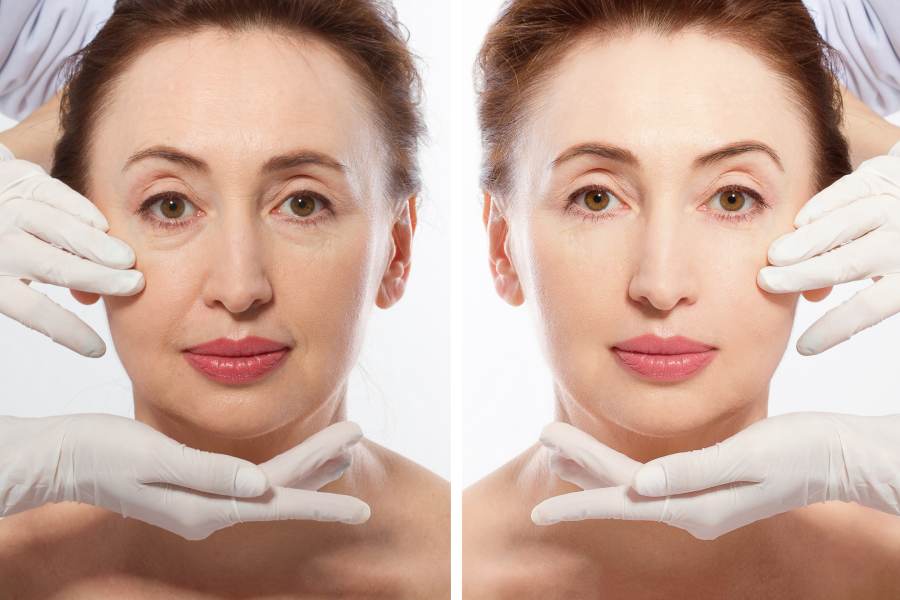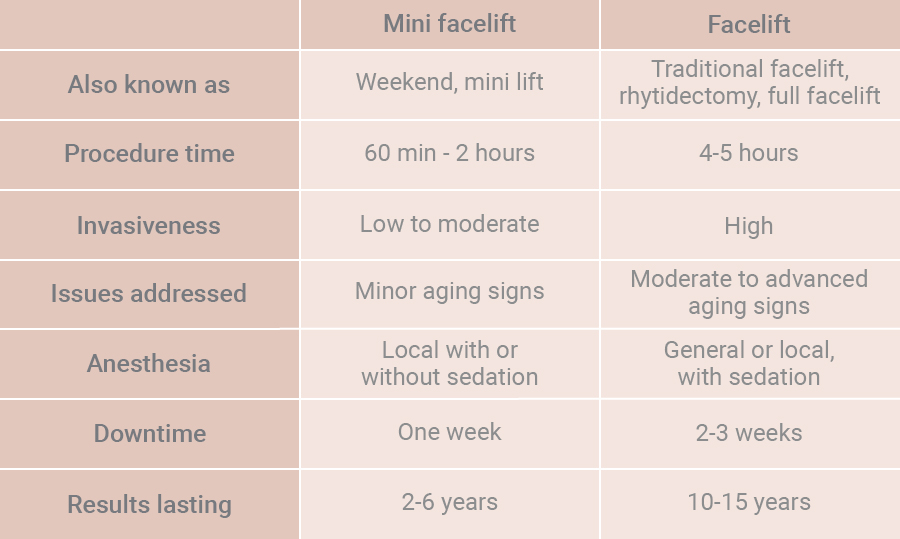Aging is an inevitable part of life. But that does not mean you cannot prolong it, which is why many decide to invest in a facelift. Mini facelifts and full facelifts are the most requested aging procedures. But how to make a choice when it comes to a mini facelift vs facelift?
As they are different facelift procedures, you may need to decide which is for you. There are differences and similarities between these two procedures you must consider during your initial doctor consultation.
Still, before you decide which one you want to invest in, it is important to understand what both procedures entail.

Source: shutterstock.com / Photo Contributor: Zhur_Sa
Mini Facelift vs Facelift
There are several differences between a mini and full facelift despite the end goal for both being reversing the signs of aging. Mini facelifts are preventative treatments, while a facelift is a corrective procedure addressing the full face. The procedures differ in the results, invasiveness, downtime, and recovery time.
Mini Facelift and Facelift: What Do They Include?
You should consider your age when deciding which procedure to make an appointment for.
Mini facelifts are for younger patients, mainly in their early 40s, whose skin has only begun to sag. The mini facelift uses smaller incisions than a full facelift does.
A full facelift is a procedure for patients with more advanced signs of aging. Cosmetic surgeons perform facelifts on patients with mild to advanced cheek and nasolabial folds, fine lines, and sagging jowls. Here are included the laxity in the neck and jawline area.
Both mini and full facelifts aim to reverse the signs of aging.
Mini facelift
Mini facelift targets specific areas instead of addressing the whole face.
A mini facelift may involve only lifting the brows and cheeks, also known as a “ponytail lift”. Or it can be cheeks and jowl lift, which will address your cheeks and jawline. Lastly, a neck lift addresses only the neck.
The mini facelift is also known by many as “the weekend” or “the mini lift”. The mini facelift procedure uses small incisions around the ears but does not extend in front or behind them or into the hair.
The dissection, muscle tightening, and skin removal are more limited with a mini facelift. Due to the minimal invasiveness of the mini lift, it might be best for patients in the early stages of skin sagging and loss of elasticity.
Facelift
Unlike mini lifts, facelifts, known as “rhytidectomy”, address the entire face to make the skin smoother. During a facelift, a surgeon surgically removes excess skin, tightens lax muscles, and re-drapes the skin over the face and neck.
Getting a traditional facelift involves lifting your brows, cheeks, jowls, and neck. A full facelift (rhytidectomy) procedure is typically recommended for older patients experiencing moderate to advanced cheek and nasolabial sagging.
As it involves addressing the entire face, a traditional facelift might make your face tighter and smoother, so you may expect a drastic change. The incisions are also bigger – they begin around your ears and extend into your hairline, then in the front and behind your ears.
Comparison Table: Mini vs. Full Facelift

Which Facelift Is Right for You
In order to determine what type of facelift is right for you, there are some factors you need to consider. For example, consider what issues you may want to target with the procedure, your age, and whether your skin issues are moderate or advanced.
The best way to achieve satisfactory results is by picking a board-certified and reputable plastic surgeon to perform the facelift procedure. During your initial consultation, you should address your concerns and ask the doctor any questions.
Both mini and traditional facelifts are surgical procedures. But if you have minimal facial muscle sagging, your doctor will likely recommend a mini lift that targets only the problem areas.
With a facelift, you may expect the following:
- Reduction of your skin’s sagging appearance
- Reduction of power jawline excess skin
- Removal of sagging folds and excess skin on your neck
- Restoring a more youthful appearance
Incisions and lift scars
As we briefly touched upon, incision length is one of the most notable differences in the facelifts. Most skilled and reputable plastic surgeons have their own techniques for reducing or hiding lift scars.
But with a traditional lift, you may expect to have deeper and longer incisions. While with a mini lift, the incisions and scars might be naturally less noticeable, which is why it is also known as a “short scar facelift”.
On average, it may take several days after the procedure for the raised appearance of the scar tissue to flatten.
The overall healing time from a facelift procedure might be six months. During this time, the visible scars usually fade from a pink appearance to a white one that may be almost impossible to notice.

Source: shutterstock.com / Photo Contributor: dimid_86
Facelift procedure – how long does it take?
Another big difference between a mini and a full facelift is the duration of the procedure. Performing a mini facelift might take from 60 minutes to two hours, based on the surgeon and the area addressed.
But a full facelift is a much longer procedure involving the entire face. A standard rhytidectomy may usually last between four to five hours. The main reason for such a long operation time is that there are more incisions and more extensive work to reform the neck.
Local or general anesthesia
A full facelift usually involves putting the patient under general anesthesia with sedation. But in some cases, it may be done with local anesthesia.
Mini lifts are generally performed with local anesthesia with or without sedation. With local anesthesia, you should feel relaxed and pain-free without needing to be completely under.
The results and their duration
When getting a cosmetic procedure like a facelift, it is important to keep in mind that the aging process cannot be stopped. This means that the results from a mini or a full facelift will start to wane after a while.
But just because the results from a facelift are not permanent, they still last pretty long and it does not mean they are not worth it. For example, mini facelift results may last two to six years. Full facelift results may last for as long as 10 to 15 years.
Facelifts, both mini and full, might be a great way to prolong the aging signs and rejuvenate your skin.
One way to ensure the facelift results last as long as possible is by incorporating a good skincare routine and following it strictly.

Source: shutterstock.com / Photo Contributor: Ground Picture
What is their downtime?
The downtime for the mini facelift is usually one-week post-procedure. It depends on how extensive the facelift is. Even mini facelifts, despite small incisions, may involve addressing deeper layers.
Still, most mini facelifts need short recovery time, so plastic surgeons dubbed them “weekend lifts”.
In comparison, full facelifts may need one to two weeks of recovery time post-procedure. The longer recovery time associated with full facelifts is due to the extensive work done.
Due to the bruising and swelling, you may need to take one or two weeks off work for a full facelift recovery. But the sutures for both facelift procedures are usually removed six to seven days after the surgery.
Pain and facelifts
Both the mini and the full facelift are surgical operations performed under anesthesia. You should not feel pain during the procedure as you will be under local or general anesthesia.
Post-procedure, you may experience some pain depending on the bruising and swelling caused by the treatment.
Still, the post-op pain may be easily managed with pain medication. With a full facelift, you may experience more discomfort post-op. Another factor in how you handle post-procedure pain depends on personal pain tolerance.
Associated risks
As is the case with all surgical operations, facelifts also carry risks. The most common risks you may expect with mini and full facelifts include the following:
- Bleeding
- Swelling
- Visible scarring
- Numbness
But you may minimize the risks as long as you keep track of your health and strictly follow your doctor’s post-procedure plan.
Conclusion
These are the most notable differences between a mini facelift vs facelift. Both facelift procedures may provide you with the desired results. But first, you must decide which is right for you.
If you have only started noticing signs of aging, like slightly sagging skin, and you’re in your early 40s, a mini facelift might be the right choice. While for people in their late 40s and older full facelifts are usually the recommended procedures.
